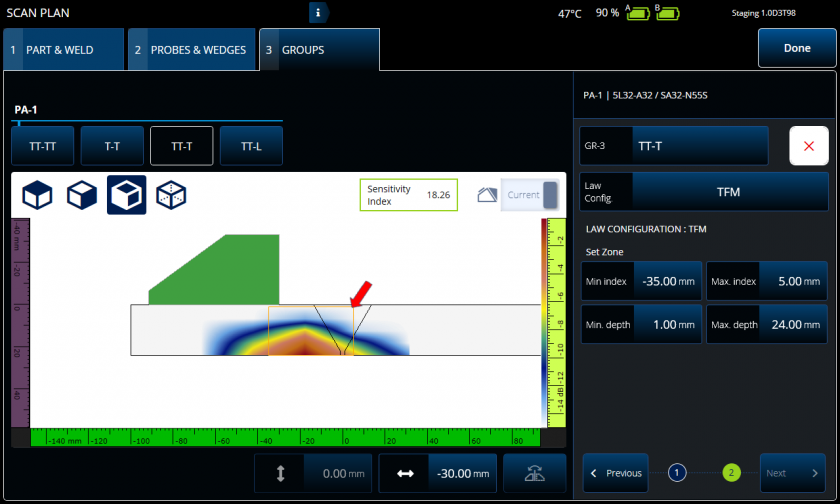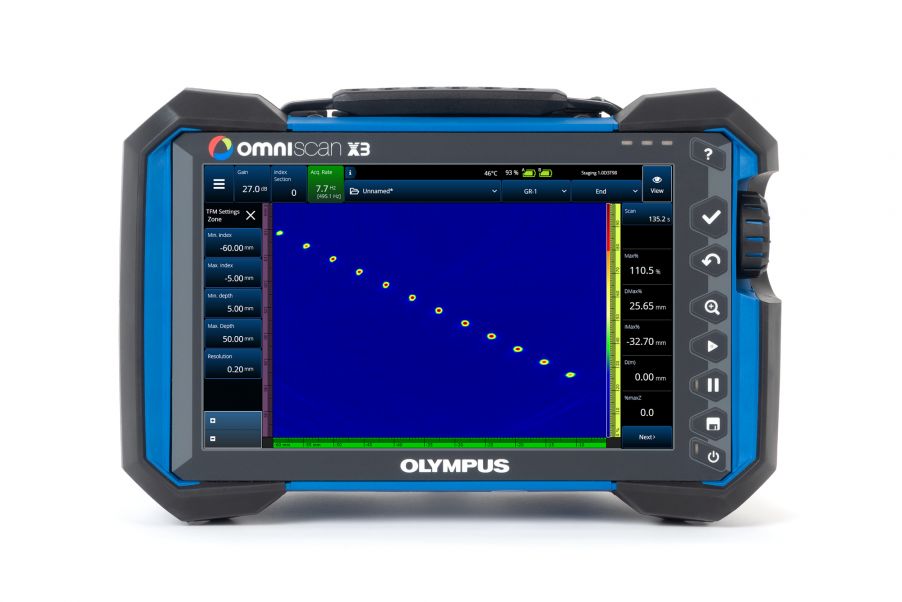Until now, the information on beam coverage provided by total focusing method (TFM) phased array ultrasonic testing (PAUT) instruments was lacking. It was basically a guessing game. Inspectors had to assume that the beam coverage was uniform throughout the target area. However, as we know, assuming does not guarantee precise results.
Knowing in advance the level of coverage provided by each propagation mode and where the signal sensitivity is best, and worst, offers inspectors a considerable advantage. They can be much more certain of each mode’s capability to detect the type of flaw that they’re looking for. And in the inspection business, increased certainty is a major benefit.
Acoustic Region and the Total Focusing Method (TFM)
Although the total focusing method (TFM) has been used for decades in the medical industry and for a few years in NDT, inspectors using this method were often subjected to a lot of trial-and-error to achieve the proper results. The overwhelming options for propagation modes (imaging paths or acoustic paths) could leave the user confused and the inspection results unpredictable.
With a typical TFM system, the user takes for granted that the region of acoustic influence (or energy) is evenly spread over the entire targeted area on the scan plan. In reality, the level of acoustic influence varies within the TFM scan area so some flaws may not be detected with a sufficient signal-to-noise ratio (SNR). The effective acoustic influence is affected by many factors, including velocity of the material, frequency of the probe, flaw directionality, and so on. More importantly, the acoustic influence is strongly dependent on the chosen inspection mode.
The Challenge of Working with TFM
This method of creating a zone to work in can give the user false expectations. The beam focusing performed by the software post-acquisition is also limited by the physics of ultrasound, just like conventional PAUT. Certain beams simply cannot reach all areas of the zone with the assumed focusing power.
For example, in TTT mode, it’s not possible to achieve an acoustic sensitivity that is high enough to detect a reflector in the upper-right-hand corner of the zone (see the screen shot below). However, an operator could easily assume that this section is covered by the zone and believe it to be in focus.

AIM modeling tool— the red arrow was added to highlight the lack of amplitude response in the upper-right corner of the zone for a TT-T wave set on a planar defect
Improving Your AIM
The Acoustic Influence Map (AIM) is a modeling tool that guides the user in selecting the right mode for the right flaw. The tool creates a model, directly onboard the OmniScan™ X3 flaw detector, that represents an amplitude map in the delineated zone. The map is color-coded:
- Red areas mean that the ultrasonic response is very good and varies between 0 dB and −3 dB with respect to the maximal amplitude
- Orange areas vary between −3 dB and −6 dB from the maximal amplitude
- Yellow areas between −6 dB and −9 dB
- And so on…
Inspectors can choose between an omni-directional reflector (volumetric), such as porosity, or a more planar reflector, such as a crack. Adjusting for the defect type updates the AIM model, showing the difference in amplitude for a given flaw using a given mode.

AIM modeling tool—as the reflector angle value is adjusted, the AIM model changes accordingly
This feature enables inspectors to compare the coverage of each mode and ensure that they will achieve the optimal signal sensitivity for detection in the defined zone. Before even beginning the inspection, inspectors can be confident in the knowledge that they are using the appropriate mode for the type of flaw they’re targeting.
Related Content
5 Reasons to Switch to the OmniScan X3 Flaw Detector
White paper: TFM Acoustic Influence Map
Get In Touch


